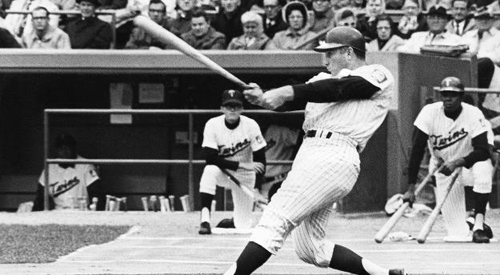
Farewell, Harmon
It is with great sadness that we discuss yesterday’s passing of legendary Hall of Fame slugger Harmon Killebrew at age 74.
Since last Friday’s announcement that Killebrew would be stopping treatment in his fight with esophageal cancer and entering hospice care, there has been an outpour of support for the famed Minnesota Twin.
For those new to baseball and fans too young to remember Killebrew’s playing days, myself included, you may be wondering what made him so special.
The Numbers
At an early age Killebrew realized he could hit the ball farther than most of his counterparts and sacrificed other aspects of the game for the long ball. The free swinging Killebrew’s 573 career home runs, 11th-highest all-time, do not seem as impressive today as they did when he retired in 1975. Back then, however, he firmly held the fifth spot on the all-time list. He also hit 40 or more home runs in eight seasons, second all-time behind Babe Ruth.
His ability to intimidate opposing pitchers made him one of the most feared sluggers of his era, primarily due to his ‘tape measure’ shots. Among his notable blasts, the 1969 AL MVP holds the record for the longest home run hit at the old Metropolitan Stadium.
“It was scary to face him. He was built like a tank, with tremendous shoulders and back muscles,” former Yankees All-Star pitcher Mel Stottlemyre said about Killebrew in a recent article in the New York Times.
[php snippet=1]
In that same article, former Chicago White Sox right-hander Gary Peters added that Killebrew had “at least as much power” as Mickey Mantle and Frank Howard, but that he could at least get them out on his pitches. A .256 career average be damned, anyone who is judged more favorably by their peers than Mickey Mantle, regardless of the context, is astounding.
Hall of Fame
Killebrew was elected to the Hall of Fame in 1984. Having retired in 1975, that meant he was eligible in 1981 for induction. You may be asking, why was a guy who was so dominant forced to wait until his fourth year of eligibility to get inducted?
There are many ways to argue this, but one notable reason was the people that Killebrew was competing against. In 1981, the only inductee by the BBWAA was Bob Gibson. In 1982, both Frank Robinson and Hank Aaron were inducted. 1983? Brooks Robinson and Juan Marichal.
Killebrew had the unfortunate luck of first appearing on the Hall of Fame ballot in years when his competition was some of the finest players in the history of baseball, a clear example of how the National Baseball Hall of Fame is notoriously difficult to get into.
A Special Twin, a Special Man
What is not up for debate is Killebrew’s character. One of the greatest players in Twins history, Killebrew is enshrined in bronze alongside other team greats such as Rod Carew, Kirby Puckett and Tony Oliva outside of Target Field in Minneapolis.
Killebrew is not only enshrined as a slugger, but as a gentleman. In an era that has long forgotten the reverence once paid to athletes as leaders in the community, Jane Forbes Clark, chairman of National Baseball Hall of Fame and Museum, spoke volumes of Killebrew’s character.
“Harmon was a beacon of light among his fellow Hall of Famers, always smiling, always enjoying every moment that life delivered to his doorstep. We have so many fond memories of this wonderful baseball hero, and we will miss him enormously,” she told he Associated Press.
He will continue to be remembered, as according to some, it’s Killebrew’s silhouette in Major League Baseball’s logo. While there is still debate on whether or not Killebrew was the inspiration for the logo, the resemblance is uncanny, and no professional has ever publicly questioned the idea, given his accomplishments on and off the field.
Killebrew was as beloved a character as there can be found in sports. Twice a Twins broadcaster in his career after baseball, the modest Killebrew was father of nine children, warm to fans, and a mentor for young players up until his last days.
He will be greatly missed.
[php snippet=1]

